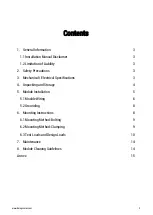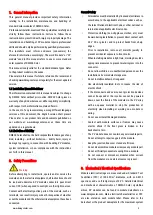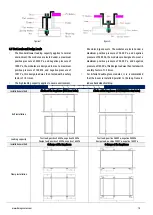
DMEGC Solar PV Modules Installation Manual
•
Keep all electrical contacts clean and dry at all times.
•
Do not expose the modules and its electrical contacts to
any unauthorized chemical substance (e.g. oil, lubricant,
pesticide, etc.).
Product Identification
•
Each module has two or three identical barcodes (one in
the laminate under the front glass, the second on the rear
side of the module and the third on the frame) that act as
a unique identifier.
•
A nameplate is also affixed to the rear of each module.
This nameplate specifies the model type, as well as the
main electrical and safety characteristics of the module.
5.
Module Installation
Precautionary Measures and General Safety
•
Prior to installing modules please obtain information
about any requirements and necessary approvals for the
site, installation and inspection from the relevant
authorities.
•
Check applicable building codes to ensure that the
construction or structure (roof, facade, support, etc.) can
bear the module system load.
•
DMEGC Solar
’s
standard modules have been qualified for
Application Class A (equivalent to Safety Class II
requirements). Modules rated under this class should be
used in systems operating at voltage above 50V or power
above 240W, where general contact access is anticipated.
•
DMEGC Solar
’s
standard modules have been certified as
Class C according to IEC 61730-2 for fire class
performance, please refer to the datasheet or the product
nameplate for the detailed types.
•
Consult your local authority for guidelines and
requirements for building or structural fire safety. When
installing modules, ensure the assembly is mounted over
a fire-resistant roof covering rated for the application.
•
The fire rating for this module is only valid when the
product is installed as specified in the mechanical
mounting instructions.
Environmental Conditions
•
PV modules are intended for use in general open-air
climates, as defined in IEC 60721-2-1: Classification of
environmental conditions Part 2-1: Environmental
conditions appearing in nature
−
Temperature and
humidity.
•
It is recommended that PV modules are installed in an
environmental temperature range of -40 °C to + 85 °C.
•
Please consult the DMEGC Solar
’s
technical support
department for more information on the use of modules
in special climates, such as an altitude greater than
2000m.
•
Do not install modules near open flames or flammable
materials.
•
Do not immerse modules in water or constantly expose
modules to water (either fresh or salt, i.e. from fountains,
sea spray).
•
Exposing modules to salt (i.e. marine environments) or
sulfur (i.e. sulfur sources, volcanoes) incurs the risk of
module corrosion.
•
Do not expose modules and their connectors to any
unauthorized chemical substances (e.g. oil, lubricant,
pesticide, etc.), as modules may incur damages
。
DMEGC Solar
’s
Modules have passed the
IEC61701 salt-mist, but galvanic corrosion can occur
between the aluminum frame of the Modules and
mounting or grounding hardware if such hardware is
comprised of dissimilar metals. DMEGC Solar
recommends that when the module is installed in salt-
damaged areas such as the sea, the module should be
installed at a distance of more than 500m from the
coastline. The offshore installation needs to be confirmed
with DMEGC Solar and installed after approval.
Installation Requirements
•
Ensure that the module meets the general technical
system requirements.
•
Ensure that other systems components do not damage
the module mechanically or electrically.
•
Modules can be wired in series to increase voltage or in
parallel to increase current. To connect modules in series,
connect the cables from the positive terminal of one
module to the negative terminal of the next module.
To connect in parallel, connect the cables from the
positive terminal of one module to the positive terminal
on the next module.
•
The quantity of bypass
diodes in the module’s junction
box provided may vary depending on the model series.
•
Only connect the quantity of modules that corresponds to


































